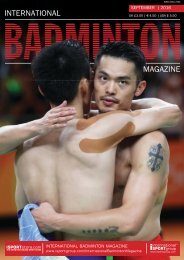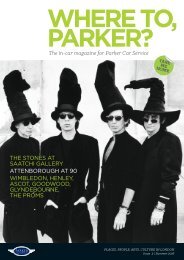Surbiton_Trophy_Programme_2017
You also want an ePaper? Increase the reach of your titles
YUMPU automatically turns print PDFs into web optimized ePapers that Google loves.
technology<br />
Firstvision has invented<br />
a video camera that<br />
slots into the chest area<br />
of a player’s shirt.<br />
The results are<br />
astounding: you see<br />
the player’s racket<br />
close-up as he<br />
strikes the ball, and<br />
as he prepares for<br />
the ball toss.<br />
photos of the All England Club. He says safety<br />
regulations currently prohibit drones operating<br />
directly above tennis tournaments packed with<br />
thousands of spectators. And just as well if you<br />
recall how, in September 2015, at the US Open, a<br />
drone operated by an amateur cameraman crashlanded<br />
into empty seating in the Louis Armstrong<br />
stadium. Fortunately no one was injured but the<br />
Italian player Flavia Pennetta, who was competing<br />
against Romania’s Monica Niculescu, said she<br />
thought it had been a terrorst attack.<br />
“A little bit scary,” she said after the match.<br />
“With everything going on in the world, I thought:<br />
‘OK, it’s over.’ If there had been spectators, it would<br />
have hit them and done a lot of damage.”<br />
Fortunately, drone technology is improving<br />
all the time. “Drones are getting smaller and<br />
more reliable,” Pocock says. “Some even feature<br />
parachutes in case the motors fail.” He believes<br />
that in a few years’ time aerial drones will be an<br />
indispensable tool for all major tennis broadcasting<br />
teams.<br />
Shirt cams are another intriguing piece of<br />
TV technology. Spanish company Firstvision has<br />
invented a tiny, unobtrusive camera that fits into<br />
the chest area of a player’s shirt, beaming out live<br />
footage. On a tennis court it allows viewers to see<br />
the court as if they were actually playing on it.<br />
The company tested their device on the courts<br />
of the Academia Sanchez-Casal, in Barcelona<br />
(Andy Murray’s old alma mater). The results are<br />
astounding: you see the player’s racket close-up as<br />
he strikes the ball, and as he prepares for the ball<br />
toss. You get an intimate view when he wipes sweat<br />
off his brow, drinks from a water bottle and pulls<br />
up his socks at change of ends. And you hear him<br />
grunting, groaning and cursing during play, more<br />
clearly than if you were his doubles partner.<br />
At professional level the results would be<br />
even more impressive. Imagine how thrilling (or<br />
frightening) it would be to face Milos Raonic’s<br />
serve, or to find yourself in between the umpire<br />
and Nick Kyrgios’s chest just as an argument kicks<br />
off – with all the accompanying sound effects. If<br />
the language gets too fruity, all you do is turn the<br />
volume down.<br />
Talking of fruity language, what about coach<br />
mikes? At Davis Cup and WTA events, where<br />
courtside coaching is permitted, why shouldn’t<br />
coaches be miked up so that spectators can<br />
14 Aegon surbiton trophy <strong>2017</strong>

















